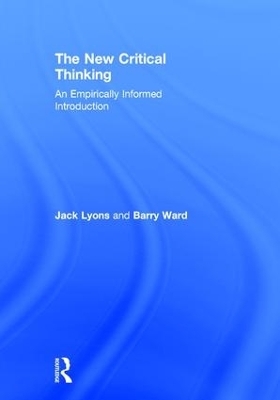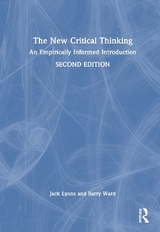
The New Critical Thinking
Routledge (Verlag)
978-1-138-68747-9 (ISBN)
- Titel erscheint in neuer Auflage
- Artikel merken
Why is it so hard to learn critical thinking skills?
Traditional textbooks focus almost exclusively on logic and fallacious reasoning, ignoring two crucial problems. As psychologists have demonstrated recently, many of our mistakes are not caused by formal reasoning gone awry, but by our bypassing it completely. We instead favor more comfortable, but often unreliable, intuitive methods. Second, the evaluation of premises is of fundamental importance, especially in this era of fake news and politicized science.
This highly innovative text is psychologically informed, both in its diagnosis of inferential errors, and in teaching students how to watch out for and work around their natural intellectual blind spots. It also incorporates insights from epistemology and philosophy of science that are indispensable for learning how to evaluate premises. The result is a hands-on primer for real world critical thinking. The authors bring over four combined decades of classroom experience and a fresh approach to the traditional challenges of a critical thinking course: effectively explaining the nature of validity, assessing deductive arguments, reconstructing, identifying and diagramming arguments, and causal and probabilistic inference. Additionally, they discuss in detail, important, frequently neglected topics, including testimony, the nature and credibility of science, rhetoric, and dialectical argumentation.
Key Features and Benefits:
Uses contemporary psychological explanations of, and remedies for, pervasive errors in belief formation. There is no other critical thinking text that generally applies this psychological approach.
Assesses premises, notably premises based on the testimony of others, and evaluation of news and other information sources. No other critical thinking textbook gives detailed treatment of this crucial topic. Typically, they only provide a few remarks about when to accept expert opinion / argument from authority.
Carefully explains the concept of validity, paying particular attention in distinguishing logical possibility from other species of possibility, and demonstrates how we may mistakenly judge invalid arguments as valid because of belief bias.
Instead of assessing an argument’s validity using formal/mathematical methods (i.e., truth tables for propositional logic and Venn diagrams for categorical logic), provides one technique that is generally applicable: explicitly showing that it is impossible to make the conclusion false and the premises true together. For instructors who like the more formal approach, the text also includes standard treatments using truth tables and Venn diagrams.
Uses frequency trees and the frequency approach to probability more generally, a simple method for understanding and evaluating quite complex probabilistic information
Uses arguments maps, which have been shown to significantly improve students’ reasoning and argument evaluation
Jack Lyons is Professor of Philosophy at the University of Arkansas. He is the author of Perception and Basic Beliefs (2009). Barry Ward is Associate Professor of Philosophy at the University of Arkansas, Fayetteville.
Table of Contents
Acknowledgements
Preface to Instructors
Introduction To Critical Thinking
1. The Aims and Causes of Belief
2. Reasoning and Dual Systems Theory
3. Reasoning, Evidence, and Arguments
4. Why Reason (Properly)?
5. Plan for the Book
Summary
Part I: Deduction
Chapter 1: Validity: Why it Matters
1. Distinguishing the Good From the Bad
2. Validity and Impossibility
3. More on Logical Impossibility
Logical Terms
Equivocation
4. Logic and the Belief Bias
5. Why it Matters: Missing Premises and Insisting on Validity
Summary
Chapter 2 : Proving Invalidity and Proving Validity
1. Proving Invalidity by Counterexample
2. Proving Validity
3. Negations, Indicative Conditionals, and Two Important Valid Argument Forms
Conditionals and the Wason Test
4. Two Important Fallacies: Denying the Antecedent and Affirming the Consequent
An Important Note about Fallacious Argument Forms
5. More Valid Argument Forms and More About Conditionals
6. Equivalent Sentences and Disguised Conditionals
7. Even More Valid Argument Forms: Aristotelian Syllogisms in One Bite
Using Euler Diagrams:
8. Summation: Evaluating Arguments
Summary
Chapter 3. Reconstructing and Identifying Deductive Arguments
1. Identifying by Evaluating
2. Mapping Complex Arguments
3. Reconstructing by Connecting the Dots
4. Extra Help: Premise and Conclusion Indicators
5. Putting All This Together
Summary
Part II: Induction
Chapter 4: Inductive Arguments
1. Statistical Syllogism
Conditional Support Comes in Degrees
Undermining By Additional Information and the Requirement of Total Evidence
2. Defeaters and Mapping Inductive Arguments
3. Inductive Generalization
Defeaters for Inductive Generalizations
The Availability Heuristic
4. Argument from Analogy
Defeaters for Analogical Inference
Deductive Arguments with Analogical Premises
5. Inference to the Best Explanation
6. Balance of Features
7. Confirmation Bias
Summary
Chapter 5: Causal Inference
1. The Nature of Causation
One More Thing about Causation
2. "The" Cause? Singling out Causes in a Complex World
3. Identifying Causes
4. Causation, Correlation, and Confounds
Some Varieties of Causal Investigations
Better and Worse
5. Causal Narratives
6. Singular Causes Revisited
Summary
Chapter 6: Probability and Frequency
1. Introduction to Probability
Probabilities and System 1
2. Frequencies and Frequency Trees
3. The Probability Calculus
4. Bayes’s Theorem
The Theorem
Frequency Trees and Bayes
5. Lies, Damned Lies, and Statistics
"Averages"
How to Live
Effect Size and Effect Significance
Summary
Chapter 7: Reconstructing and Identifying Arguments, Revisited
1. Reconstructing and Identifying
2. Mapping More Complex Arguments
Part III: Truth: Evaluating Premises
Chapter 8: Testimony
1. The Need for Testimony
2. How Can you Spot the Experts if You’re Not an Expert?
Sincerity, Competence, Trustworthiness
Mapping Arguments from Authority
Testimony and Ad Hominem
3. Epistemological Perils of the Internet
News, Unreliable News, and Fake News
4. Wikipedia
5. Fair and Balanced?
Summary
Chapter 9: Science
1. Disagreeing with Science: The Earth is Flat and Star Trek is Real
2. Why Trust Science?
3. How Does Science Work?
Provability
Falsifiability
4. Hypotheses, Theories, and Conjectures
5. Extended Example: Evolution and Historical Explanation
6. Science in the Non-Science Press
P-hacking
7. Applying What We’ve Learned: Crowds, Self-selection, and Causal Fallacies
Democracy and Scientific Fact
Summary
Part IV: Argumentation
Chapter 10: Rhetoric
1. Emotion and Belief
2. Influencing and Bypassing Reasoning
Apt Feelings
3. Abuses of Emotive Rhetoric
Ad hominem
Ad Populum and Peer Pressure
Appeals to Force, Pity and Consequences
Other Uses of Emotive Language
4. Rhetorical Tricks with Language
5. Enthymemes, again
6. Rhetoric and Cognitive Illusion
Summary
Chapter 11: Dialectic
1. The Dynamics of Argumentation
The First Golden Rule of Constructive Argumentation: Respond to the Argument
The Second Golden Rule: Track the Burden of Proof
The Third Golden Rule: Demand Overall Consistency
The Fourth Golden Rule: Be Charitable
2. Ultimate Premises
Depriving the Claimant of Premises
3. Analogy, Parity of Reasoning, and Tu Quoque
Summary
Appendix of Fallacies
Index
| Erscheinungsdatum | 29.09.2017 |
|---|---|
| Zusatzinfo | 21 Tables, black and white; 39 Line drawings, color; 30 Line drawings, black and white |
| Verlagsort | London |
| Sprache | englisch |
| Maße | 178 x 254 mm |
| Gewicht | 1088 g |
| Themenwelt | Geisteswissenschaften ► Philosophie ► Erkenntnistheorie / Wissenschaftstheorie |
| Geisteswissenschaften ► Philosophie ► Logik | |
| ISBN-10 | 1-138-68747-2 / 1138687472 |
| ISBN-13 | 978-1-138-68747-9 / 9781138687479 |
| Zustand | Neuware |
| Informationen gemäß Produktsicherheitsverordnung (GPSR) | |
| Haben Sie eine Frage zum Produkt? |
aus dem Bereich


![Was heißt Denken?. Vorlesung Wintersemester 1951/52. [Was bedeutet das alles?] - Martin Heidegger](/media/113619842)
